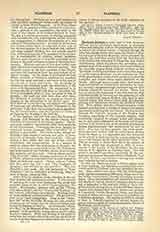

Flathead Indians, a name used in both Americas, without special ethnologic significance, to designate tribes practising the custom of compressing the skull in infancy by artificial means. Curiously enough the tribe best known under this name, the Salish or Flathead proper of Western Montana, never practiced the custom, the confusion arising from the fact that the early traders felt compelled to adopt the local Indian classification, which considered the prevailing compressed skull of the neighboring tribes as pointed and the naturally shaped Salish skull by contrast as flat. The Salish or Flathead Indians of the mountain region of northwestern Montana are the easternmost tribe of the great Salishan stock which occupied much of the Columbia and Fraser River region westward to the Pacific. Although never a large tribe, they have always maintained an exceptional reputation for bravery, honesty, and general high character and for their friendly disposition towards the whites. When first known, about the beginning of the last century, they subsisted chiefly by hunting and the gathering of wild roots, particularly camas, dwelt in skin tipis or mat-covered lodges, and were at peace with all tribes excepting their hereditary enemies, the powerful Black-feet. Their religion was the ordinary animism of the Indians and they had a number of ceremonial dances, apparently including the Sun Dance. Having learned through the Catholic Iroquois of the Hudson Bay Company something of the Catholic religion, they voluntarily adopted its simpler forms and prayers, and in 1831 sent a delegation all the long and dangerous way to St. Louis to ask of the resident government Indian superintendent that missionaries be sent to them. This was not then possible and other delegations were sent, until in 1840 the noted Jesuit Father Pierre-Jean de Smet (q.v.) responded and was welcomed on his arrival in their country by a great gathering of some 1600 Indians of the allied mountain tribes. In 1841 he founded on Bitter Root River the mission of St. Mary, which was abandoned in 1850, in consequence. of the inroads of the Blackfeet, for the new mission of St. Ignatius on Flathead Lake. This still exists in successful operation, practically all the confederated Indians of the reservation—Flathead, Pend d’Oreille, Kutenai, and Spokan—having been consistent Catholics for half a century.
In 1855 the Flatheads made a treaty ceding most of their territory, but retaining a considerable reservation south of Flathead Lake and including the mission. They number now about 620, the confederated body together numbering 2200 souls, being one of the few Indian communities actually increasing in population. They are prosperous and industrious farmers and stockmen, moral, devoted Catholics, an in every way a testimony to the zeal and ability of their religious teachers, among whom, besides De Smet, may be named such distinguished Jesuit priests and scholars as Canestrelli, Giorda, Mengarini, Point, and Ravalli, several of whom have made important contributions to Salishan philology. The mission is (1908) in charge of Rev. L. Tallman, assisted by several Jesuits, together with a number of Christian Brothers, Sisters of Providence, and Ursulines.
JAMES MOONEY

